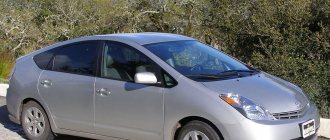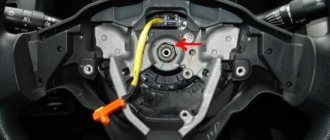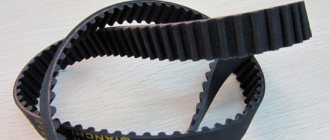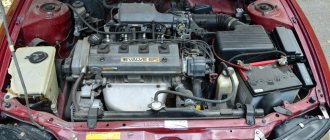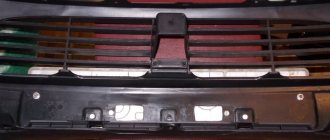Prius in Latin means “original, first, advanced.” Toyota Prius is truly the founder of the hybrid movement, it is still produced, it has become the most popular hybrid, has won many awards and is one of the most reliable cars in the world.
The number of Priuses on the roads of Ukraine is growing and the number of people wishing to buy this hybrid is increasing. If you also want to join the club of happy car drivers, then when buying a used car. it is necessary to exclude the possibility of buying a hybrid with a dead high-voltage battery (VVB). To do this, you need to know how to check the Prius (Toyota) battery.
How to check the Prius 20 battery?
In the same way as checking the Prius 30 battery. And the best way to do this is to diagnose the VVB at a specialized service station. This does not require large financial and time expenditures. For example, here it costs 300 UAH. and takes no more than half an hour. If you are in Kyiv, then call and make an appointment.
But what to do if, when buying a car, there is no opportunity to go to a good auto repair shop? Then it will be useful for you to know 4 ways to check the battery of the Prius 20, Prius 30 and subsequent models with nickel-metal hydride (Ni-MH) VBB. You can do these tests yourself; they do not require diagnostic equipment. Of course, they are not accurate, but the killed VVB will certainly be identified.
The first way to check the Prius battery is by fuel consumption
To do this, you need to know the average fuel consumption over the last couple of hundred kilometers. If the VVB is good, then the owner most likely will not reset the consumption meter to boast about its low value. Of course, the average consumption greatly depends on many factors, but if over the last 500 km in the city it is 5.5 l/100 km, then most likely the VVB is alive. If the counter has recently been reset, then move on to the next option to check the Prius battery.
The second way to check the Prius battery is by acceleration
We park the warmed-up car at the nominal charge level of the VVB near an area where it is safe to accelerate to at least 80 km/h, and wait until the internal combustion engine stalls. Then we start moving slowly on the battery and sharply press the gas all the way. In a second, the internal combustion engine will pick up speed and the hybrid will turn on all its resources for acceleration.
If at the same time you get impressive, uniform acceleration without jerking or dips, and after acceleration the charge level does not drop by more than one notch, then everything is OK with the hybrid system. If you extend this pleasure to 120 km/h, then the VVB charge is allowed to drop by two divisions. It is clear that you also checked the internal combustion engine.
The third way to check the Prius battery is by mileage on VVB
Warm up the car completely. The VVB charge must be nominal: two divisions to full. We accelerate to about 50 km/h and turn off the air conditioning, stove and all other consumers. We wait for the engine to stall and reset the odometer. We drive evenly. If the mileage before turning on the internal combustion engine is about 2 km, then the battery is not dead.
If the Prius is equipped with an EV button, then you can drive on electric power right from the start. But the car must also be warmed up. In this case, the energy of the VVB is also spent on acceleration, so the “electric range” will be somewhat less. But it should not be lower than 1.5 km.
The fourth way to check the Prius battery is in the parking lot.
We measure the downtime time before the VVB discharge. As in the previous test, the car must be completely warmed up, the VVB charge level must be nominal, and all consumers must be turned off. From the moment the engine stops, we note the time, and if this is a car purchase, then we begin external and internal inspection, negotiations, bargaining, etc. With a live battery, the internal combustion engine will start in about 20 minutes.
Power distribution device
The torque and energy of the internal combustion engine and both motor/generators are combined and distributed by a planetary gear set, called a Power Split Device (PSD) by TOYOTA. And although it is quite simple to manufacture, it is not so easy to immediately understand how it works. Therefore, we will devote enough time to it. PSD allows the Prius to operate in three modes simultaneously - as a series hybrid, as a parallel hybrid and as a series-parallel hybrid. At the same time, get the benefits of each of them.
Thus, the internal combustion engine can spin the wheels directly (mechanically) through the PSD. At the same time, a variable amount of power can be removed from the internal combustion engine, turning this rotational energy into electrical energy. It can charge the battery or be sent to one of the motors/generators to help turn the wheels. The flexibility of this mechanical/electrical power distributor allows the Prius to improve fuel economy and reduce emissions while driving. This is impossible with a rigid mechanical connection between the internal combustion engine and the wheels, implemented in a parallel hybrid. And it is unattainable for a series hybrid without loss of electrical energy.
Prius K10 standard monitor with the ignition on. In this case, the standard charger cannot be activated in any way. The monitor is installed in the center of the car’s front console
PSD Prius K30 in the box section
The Prius has a transmission called CVT (Continue Variable Transmission). In Russian, this term sounds like “continuously variable” or “constantly variable” transmission. Its basis is the power distribution device PSD. This CVT operates exactly the same as a conventional automatic transmission, except that the gear ratio can change continuously and smoothly rather than in short increments: first gear, second, third, etc. Later we will look at how the operation of PSD differs from the features of a conventional continuously variable transmission, i.e., a CVT.
Let's summarize the results of checking the Prius battery:
- Let’s immediately make a reservation that at sub-zero temperatures the car needs to be warmed up very well: drive actively for at least 10 km, otherwise the results of tests 3 and 4 will be significantly lower.
- If in the second and third tests the VVB showed itself to be excellent, then the fourth test need not be done, the battery is alive.
- If the consumption is high, or is not clear, and the VVB did not pass the test in the second and third tests, then you don’t have to do the fourth either, it’s better to go for diagnostics. Or refuse the purchase. Or give us a call to find out what our current Prius high voltage battery replacement cost is.
- If one of the tests, the second or third, showed results below normal, then it must be repeated. And do the fourth test. If everything is OK according to them, then one low result popped up by chance and can be ignored. But if there are repetitions, then VVB is tired. Refuse to buy, or bargain so that its future repairs pay off. Call us and find out the cost of repairing the VVB Prius.
- If checking the Prius battery resulted in a hybrid system error indication, stop the tests and proceed as indicated in step 3.
In conclusion, we will please you with the fact that in this way you can check the Ni-MH VVB of almost all Toyota/Lexus hybrids, so as not to get a dead battery. But a more accurate condition of the VVB can only be determined through professional diagnostics.
ENNOCAR and ENNOPRO – who are they?
ENNOPRO is a group of companies, and ENNOCAR is one of their brands.
Here are some facts about ENNOPRO that make them the best aftermarket hybrid battery manufacturer and the ENNOCAR brand the best Ni-MH HV battery brand:
- ENNOPRO has been in the battery industry for 12 years (since 2008)
- The ENNOCAR brand has been produced for 8 years (since 2012)
- There are CE and UL safety certificates, which allows ENNOCAR batteries to be supplied to Europe and the USA.
- The manufacturer provides a 3-year or 100 thousand km warranty on ENNOCAR batteries, whichever comes first.
- ENNOPRO states that all ENNOCAR batteries actually have a capacity of 6000 - 6500 mAH (minimum - 5800mAh), while other Chinese manufacturers sell cells with a real capacity of 5300-5800mAh.
- The current characteristics are 30C per discharge, while other manufacturers have 25C.
- Warranty cases are rare, and cases of loss of tightness are extremely rare: 1/10000.
- ENNOCAR batteries undergo rigorous testing, including high temperature testing.
- ENNOCAR batteries are sold worldwide through a growing distribution network that now covers more than 55 countries.
Capacity measurement, Repair of VVB battery Toyota Prius 30
Repair of the high-voltage battery of Toyota Prius 30, measuring the capacity and then selecting pairs of elements.
No duplicates found
It’s interesting: I always have the radio playing on my computer, at a comfortable volume.
If I need to watch a video, I turn off the radio, and most of the videos, not all, unfortunately, are played at a comfortable volume.
Those that I can’t hear, I just turn them off.
Because turning the volume back and forth on the speaker is not at all interesting to me.
If the author of the video cannot display normal volume in the video, he does not respect me, why would I watch it?
By the way, no one will say offhand what level of sound signal should be in the video?
If suddenly (which is very unlikely) I shoot a video, I’ll level the sound to a normal level, and I’ll even look and determine what a normal level is, but since I don’t need it right now, maybe someone knows and will tell those who it is necessary?
I can't hear anything. Udol!
add sound, this is not a 21+ video.
Yes, and it’s not particularly visible.
whoever understands the topic of Toyota and Lexus hybrid batteries, in the next video I will try to be louder and the background will need to be turned up.
add sound, this is not a 21+ video. set the quality higher, filmed on iPhone 8)))
How does VVB work?
A controller is installed inside the VVB case, which controls the charging of each battery unit, and also monitors the temperature and a number of other battery parameters.
When the car is moving at low speeds, it almost always drains battery power (unless the battery is very discharged) - this is due to the peculiarity of the Prius' internal combustion engine. In a situation where the car slows down, the energy, on the contrary, charges the VVB.
The process of energy consumption and recovery is controlled by a computer and occurs without user intervention.
How to use? 5 simple rules
- Prius WILL NOT DRIVE WITHOUT GASOLINE! The surest way to kill a battery is to try to drive a car without gasoline. Of course, the automation will turn off the ignition when the battery is critically low, but the “smartest” ones then turn the car on again and try to drive.
- The battery cannot be charged. NEVER CHARGE THE BATTERY! If for some reason your car runs out of battery, do not try to charge it. If it happens that the battery charge is critically low, start the internal combustion engine using a regular battery (yes, the Prius has a regular battery and a starter specifically for these purposes), the Prius will do the rest itself.
- Avoid overcharging or discharging the battery. It’s good if the battery on the screen does not fill up or empty completely when driving, it is better that one bar remains. Full filling is also not a reason to panic.
- When operating the machine in mountainous areas with long climbs, use mode B for descent. This will help avoid overcharging the battery and save the brakes.
- If you are going to carry out any body (welding?!) work, be sure to turn off the VVB. For these purposes, there is a disconnect switch in the trunk under the shelf located behind the rear backrest on the left (if you look along the car).
How to choose?
Of course, it is impossible to achieve complete confidence that VVB will live happily ever after, but there are a number of tests that will help you avoid buying low-quality VVB.
So, you got into the car and there is a dashboard in front of you. First, you need to turn on the viewing mode of “energy flows” - where the battery is drawn.
If the battery is currently charged, then turn off the climate control (air conditioning or heating, it doesn’t matter) and start moving at a low speed, 10–20 km/h, without pressing the gas sharply. Continue driving until the engine starts.
The battery should discharge gradually, there should be no sudden dips. Then turn the climate control to maximum and wait for the battery to charge. It should be fully charged or one, maximum two bars less.
If the internal combustion engine is working, but the battery refuses to charge above half, then there is a high probability that the internal combustion engine is faulty.
Also, the VBB is faulty if the battery was charged normally, but within 5–10 minutes it lost its charge by several points.
Is it possible to repair VVB?
The VVB on the Prius consists of a large number of individual elements. The advantage of this approach is the ability to replace individual cells without replacing the entire battery. VVB repairs are carried out in order to equalize the parameters of individual bundles of battery elements and bring its capacity to factory values. In this case, the battery itself is disassembled into individual elements, each of which is tested on a special stand according to a special program. After the weak cells are rejected, they are replaced according to calculations and equalization is carried out to equalize all pairs of battery cells under a certain load.
Our auto repair center carries out repairs of high-voltage batteries of hybrid cars using the most modern diagnostic stands and according to factory methods that are used at the battery manufacturer in Japan. Timely contact with specialists will save significant money. After all, the VVB is the most expensive element of any hybrid car.
With respect to you and your car, Vladimir Buyanov.
Self-replacement
To install a new starter battery you must:
- Open the trunk and remove the floor lining.
- Unfasten the protective cover of the positive terminal, and then unscrew the nuts securing the terminals to the contact pins.
- Disconnect the exhaust pipe, remove the bar and remove the battery from the mounting socket.
- Install a new battery, connect the terminals and put on the gas outlet hose, making sure that the elastic tube is securely fixed.
- Make sure that the engine starting system is working properly.
The traction battery is screwed to the floor of the body; to gain access, you need to remove the trunk trim.
The manufacturer does not recommend dismantling it yourself; removal and installation must be carried out in a service center. After installing a new or reconditioned battery, computer diagnostics of the vehicle is carried out.
Technologies for repair and maintenance of hybrid vehicles. School of Sergei Gordeev. Lesson 17
Let's refresh our memory of the end of the last (16th) lesson: “The high-voltage battery is ready for removal. The most convenient way to pull it out, as on the Prius 10, is through the rear left door. In this case, first we lift the left part of the VVB and pull it towards the left side of the car. The assistant then grabs the second edge and the battery is removed from the car.”
Let's start disassembling the VVB. In order to access the elements, we need to remove the top metal cover. We unscrew all the bolts in a circle and one bolt under TORX T30. Unclip the gas outlet tube fastening and remove the top cover.
The contact plates that connect the VVB elements in series to form a battery are covered with black plastic covers.
They have two fastenings, on top and in the middle. If everything is clear with the upper ones, then many beginners cannot figure out the middle ones and simply break the plastic part of the tire. In fact, near where the cover is attached to the tire there is a hole through which you can pry a tab that holds the cover tightly.
Photo 15. VVB Prius 11 dismantled assembled
Photo 16. VVB with the cover removed (with black covers at the edges)
Now let's look at what we see. On the left side of the VVB there is a main relay block assembled with a resistor. A wire with a connector comes out of it. It is to this connector that the wires that control the closure of the relay come from the control unit of the hybrid installation.
Tired? We rest again in practical sections
The most asked question regarding the Prius transmission is the following: what kind of oil is poured into it, how much is required, and how often should the fluid be changed? Very often there is such a misconception among car service workers: since there is no dipstick in the box, it means there is no need to change the oil there at all. This misconception has led to the death of more than one box.
Therefore, we inform you that the working fluid in the Prius transmission needs to be replaced! For modifications of this vehicle, the fluid grades and their volumes must correspond to: K10 – oil T-4/(3.8 l); K11 – T-4/(4.6 l); K20, K30 – WS/(3.8 l).
The lubricant should be changed every 40 thousand km. According to the Japanese schedule, the oil is changed every 60–80 thousand km, but for particularly difficult operating conditions (and the Japanese classify the operation of cars in Russia as just such - and we agree with them), the oil should be changed 2 times more often.
Let's talk about the main differences in gearbox maintenance, i.e., oil change work. If in K20, in order to change the oil, you just need to unscrew the drain plug and, after draining the old one, fill in the new one, then on the K10 and K11 bodies everything is not so simple. The design of the oil pan on these machines is made in such a way that if you simply unscrew the drain plug, only part of the oil will drain out, and not the dirtiest one. And 300–400 g of the most contaminated oil with various debris (pieces of sealant, wear products) will remain in the pan.
Therefore, to replace the fluid, you need to remove the pan, drain the dirt, clean it and only then put it back in place. When removing the pallet, we get another additional bonus - this is the ability to diagnose the condition of the box by the wear products located in the pallet. The worst thing for a car owner is when he can find yellow (bronze) shavings at the bottom of the pan. This will mean that such a box does not have long to live.
The original pan gasket is made from cork oak bark. If the holes on it have not become oval, it can be reused without any sealants. The main thing when installing a pallet is not to overtighten the bolts. Otherwise, you can cut the gasket using the edges of the pallet.
To be continued

